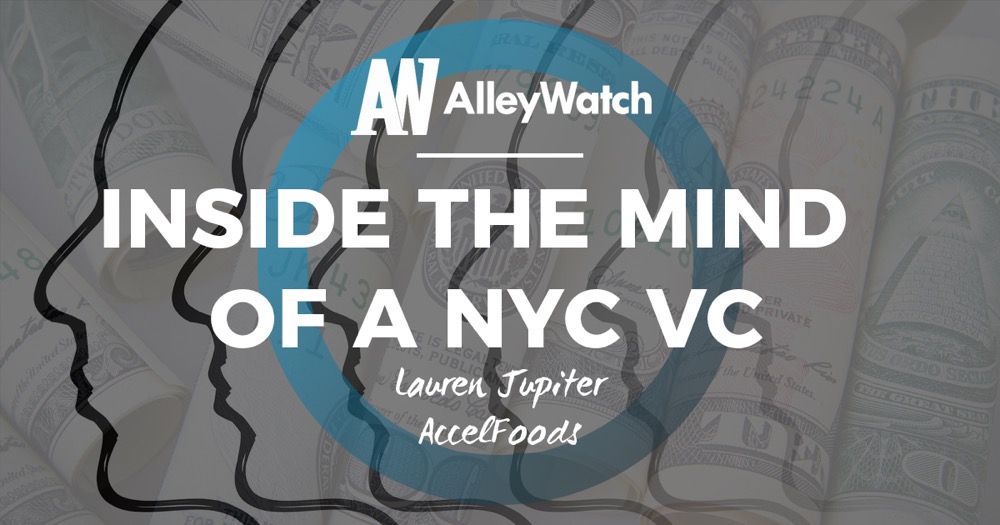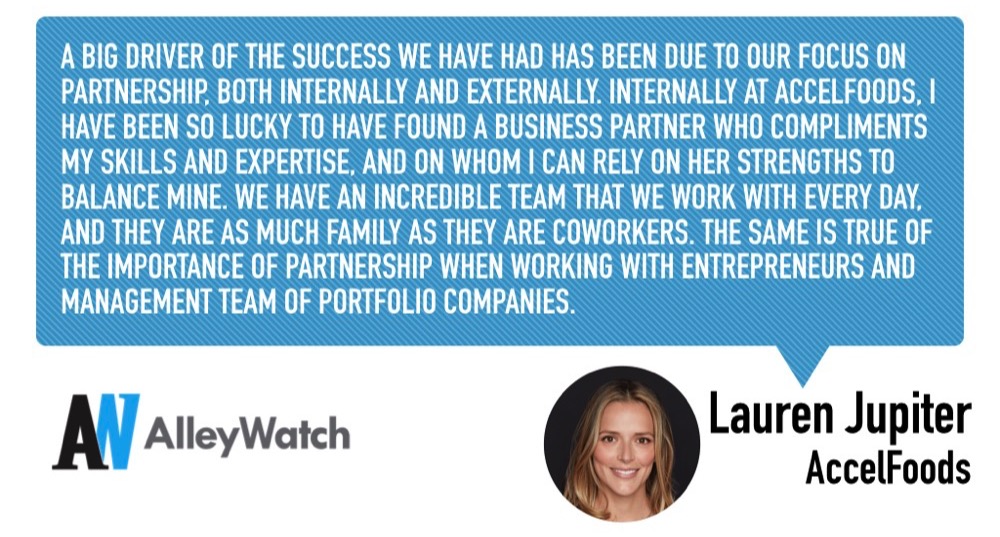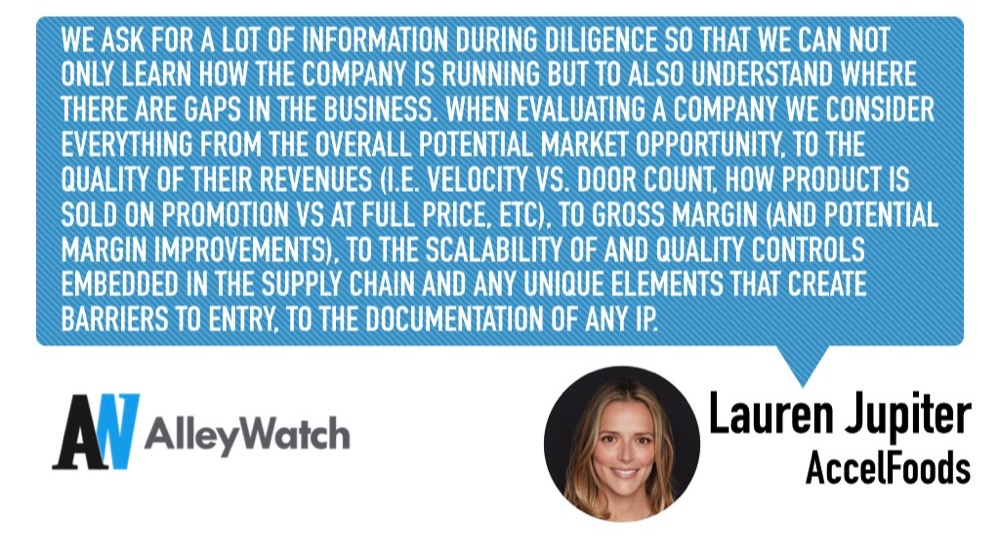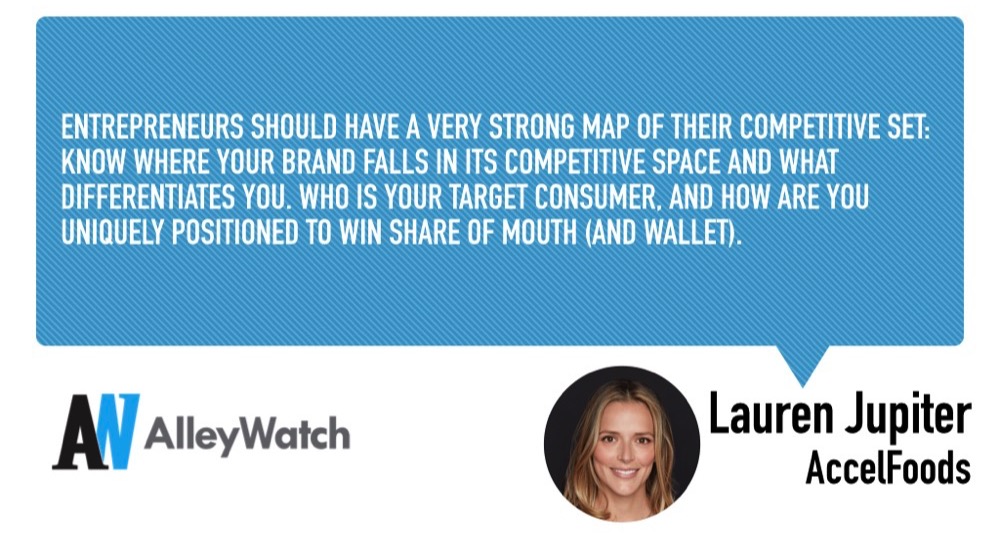Welcome back to Inside the Mind of an NYC VC, a highly acclaimed series at AlleyWatch in which we speak with New York City-based Venture Capitalists. In the hot seat this time is Lauren Jupiter, Managing Partner at AccelFoods, a NYC venture firm focused on investments in the food and beverage space that was launched in 2014. Initially launched as an accelerator, AccelFoods transitioned to a venture fund in 2016 that is currently investing out of its second fund ($35M). AccelFoods has over 35 portfolio companies including investments in Element Snacks, Wandering Bear Coffee, Bandar Foods, and Nomi.
Lauren visited us in our offices in Soho to discuss her path to venture, how her previous experience as a banker focused on consumer products and retail prepared her for her role at AccelFoods, how investment in the food and beverage space differs from traditional venture investing in tech companies, the importance of intellectual property, what entrepreneurs need to focus on and emphasize while pitching, and much, much more including how being a mom serves as an advantage when evaluating investments.
If you are a NYC-based VC interested in participating in this series, please send us an email. We’d love to chat. If you are interested in sponsoring this series that showcases the leading minds in venture in NYC, we’d also love to chat. Send us a note
Reza Chowdhury, AlleyWatch: Please tell us a little bit about your background, how you started in venture, and how you got to where you are today.
Lauren Jupiter, AccelFoods: It sounds like a bad joke, but AccelFoods started with a banker (me) and a lawyer (my co-founder, Jordan Gaspar) teaming up to invest in innovative early-stage food and beverage companies. After spending several years of working at a bulge-bracket investment bank, I wanted to transition from advising large, multinational food and beverage companies to getting more hands-on with the small, high-growth food and beverage companies that were just starting to re-shape the food and beverage ecosystem. Jordan and I saw that there was tremendous white space around investing in and supporting entrepreneurial food and beverage companies. So, working from my Greenwich Village dining room table in 2013, we launched the original model that was based on the success seen in the tech space.
Starting January 2014, we welcomed early-stage food and beverage companies to what was then an accelerator model backed by our $4M fund. In 2016, we began operating out of our second $35M fund and evolved from an accelerator into a hands-on venture fund, investing opportunistically and working collaboratively with companies.
Today, AccelFoods continues to invest in high-growth food and beverage companies with over $80M of AUM and 35 portfolio companies (and counting!). We connect the dots within the broader food and beverage ecosystem by offering emerging companies and founders the resources needed to quickly and strategically bring innovative products to market to create the next generation of enduring brands.
Tell us a bit more about AccelFoods.
 As operationally focused minority investors, we not only provide capital but also our expertise and access to proprietary relationships with retailers and distributors, large food & bev corporates, brokers, digital partners, and other service providers that would otherwise not necessarily be available to early-stage companies.
As operationally focused minority investors, we not only provide capital but also our expertise and access to proprietary relationships with retailers and distributors, large food & bev corporates, brokers, digital partners, and other service providers that would otherwise not necessarily be available to early-stage companies.
We invest in U.S. packaged food and beverage companies anywhere from pre-launch to $10M+ of revenue, and we lead and co-invest with flexible investment structures of common, preferred, or convertible debt. We invest in 6-8 new platforms annually as well as follow-on investments in existing portfolio companies with check sizes ranging from $500K to $5M.
How did working in investment banking for several years prepare you to work in venture?
Prior to founding AccelFoods, I was a consumer products and retail investment banker, largely focused on advising large-cap food and beverage companies and consumer-retail focused private equity firms. My time in investment banking not only prepared me from a fundamental skills perspective (i.e. financial modeling and analysis, diligence, etc), but also gave me exposure to how my then clients thought about developing their own growth and M&A strategies, and taught me how to think critically about how the companies we invest in can evolve into highly sought after acquisition targets.
What did you have to learn that banking may not have prepared you for?
I’ve learned that success in the food and beverage industry takes three things: dexterity, partnership, and community.
Dexterity is incredibly important for any early-stage business. Young entrepreneurial companies have an ability to be nimble that is rarely found in large multi-national companies. It is important to have a speed and agility to meet market or consumer demands and drive innovation.
A big driver of the success we have had has been due to our focus on partnership, both internally and externally. Internally at AccelFoods, I have been so lucky to have found a business partner who compliments my skills and expertise, and on whom I can rely on her strengths to balance mine. We have an incredible team that we work with every day, and they are as much family as they are coworkers. The same is true of the importance of partnership when working with entrepreneurs and management team of portfolio companies. We view founders as long-term partners with whom we want to deepen our relationship over time, and work together to build a great outcome for everyone.
Finally, it’s important to build a community around yourself and your portfolio companies. Executing on a shared vision alongside co-investors, management teams, retailers and all the other key players in the industry produces incredible outcomes.
Food is a broad sector. What types of business are most interesting? Where is AccelFoods’ sweet spot?
The food and beverage market is $635B and growing so there is so much opportunity out there. Our sweet spot is in the natural products space, which accounts for about $56B in sales and is driving significant growth across all food retail channels.
Right now, we’re keeping an eye on businesses that represent some of the macro trends we are seeing, such as ‘snackification’ and the movement away from meals, plant-based proteins, functional beverages, and children’s platforms.
We’re also interested in alternative route-to-markets, such as corporate campuses, convenience, and food service applications.
How is investing in food different than traditional venture?
There are certainly lots of similarities between investing in food and more traditional venture — we have a broad portfolio, and we know not every company will cross the finish line. We must have our finger on the pulse of the innovations, trends, and dynamics happening in our industry and take action swiftly, as we know that the biggest opportunities often lie in identifying and investing in trends before they even emerge. We don’t want to be investing in me-too products but rather investing in businesses that are forging new categories, have strong differentiation in route-to-market, and are disrupting stale categories.
With that said, there are some significant differences that impact how we think about our investment strategy and what makes a potential portfolio company attractive. Perhaps the most basic difference is the physical and perishable nature of food and beverage, which can pose significant constraints and risk. We have to think critically about manufacturing, in terms of scalability, quality, and most importantly, safety. Our portfolio companies are not only beholden to the demands of the end customer (consumers), but also the demands and timelines of the distributors and retailers that act as critical partners and intermediaries. As a result of these dynamics, growth is often seen in step functions, not straight lines, and cash flows can be extremely lumpy and inventory management a substantial challenge.
And lastly, exits in the food and beverage space often look quite different than those in more traditional venture sectors from a dollar value perspective. As we think about the companies we invest in, their growth opportunity and our ultimate potential return, we must be extremely disciplined in how we think about current valuation, cash burn and our expectations of future potential financings in order to maximize the potential return to our own investors.
I would imagine that the process for due diligence is also different when evaluating a food business. Tell us what steps does the firm takes to evaluate a food business.
When you are investing this early in a company’s lifecycle you are really betting on the jockey, which I think is probably the case across all industries making early-stage investments. We work very closely with the founders getting to know them and their teams throughout the introductory phase and diligence process. Through that period and the transaction process, we see first hand how founders conduct themselves as they work through critical aspects of their business.
Where our model is often different is in our focus on building strong infrastructure beneath each portfolio company, and that admittedly starts at the diligence process. We ask for a lot of information during diligence so that we can not only learn how the company is running but to also understand where there are gaps in the business. When evaluating a company we consider everything from the overall potential market opportunity, to the quality of their revenues (i.e. velocity vs. door count, how product is sold on promotion vs at full price, etc), to gross margin (and potential margin improvements), to the scalability of and quality controls embedded in the supply chain and any unique elements that create barriers to entry, to the documentation of any IP.
Because we are often an early partner and likely one of the first institutional investors, we are not afraid of a little clean up and the diligence process for us is both a mechanism to evaluate a potential investment opportunity as well as a mechanism to to determine what steps must be taken pre and post-closing to shore-up any gaps in a business’s infrastructure.
What metrics are most important related to food?
We tend to be most focused on two key metrics – velocity and gross margin.
Entrepreneurs often focus on the number of retail doors or distribution points that their brand has. But in reality, gaining shelf-space is “easy” — it’s keeping it that’s touch. Velocity (or the number of units per store per week per SKU that a retailer sells) is critical for understanding how a product is performing at retail. Are consumers trying the product? And if so, are they purchasing the product again? What is the average velocity in the category, and how does each SKU stack up to retailer expectations for sell-through? In the early days, we would much rather see brands that are executing well in a more concentrated number of doors than a brand that is distributed extremely widely but achieving below average velocities.
Gross Margin is the other key metric that we look at. In the early days, it is extremely hard to build a profitable business in the food and beverage space. The cost of key personnel and some basic sales and marketing initiatives mean your in the red from day one. But a strong gross margin gives us confidence that a business has the potential to become profitable once it reaches scale, either as a standalone business or under the ownership of a strategic acquirer.
What are you seeing in terms of acquisition and growth strategies in the food sector?
The M&A landscape in the food and beverage space is extremely active with a real focus on innovation being driven by emerging brands. Over the last several years, we have seen the focus on emerging brands manifest itself not only through early acquisitions, but also through large multinational firms getting more actively involved in the venture space. We’ve seen corporates make investments even in sub $1m brands to get a foothold into the products and brands that they think will be the wave of the future in the food and beverage industry.
The M&A landscape in the food and beverage space is extremely active with a real focus on innovation being driven by emerging brands. Over the last several years, we have seen the focus on emerging brands manifest itself not only through early acquisitions, but also through large multinational firms getting more actively involved in the venture space. We’ve seen corporates make investments even in sub $1m brands to get a foothold into the products and brands that they think will be the wave of the future in the food and beverage industry.
What do you need to see from teams in order to invest?
We want challenger brands that are disruptors with smart people driving smart strategies and entrepreneurs who are relentless, resourceful, and resilient.
We look for innovative products and go-to-market strategies that push the boundaries of today’s food and beverage industry. And finally, we look for brands with market opportunities and a path to grow to $100m in sales and beyond.
What metrics do entrepreneurs overlook or not place enough emphasis on that are important to consider when you are evaluating investment merit of a business?
Some entrepreneurs don’t place enough emphasis on protecting their ideas and their intellectual property. That’s the foundation of their business, after all. It’s important to build out a solid IP strategy. Make sure you are protecting your business, trademarks, manufacturing, and supply chain.
In addition, entrepreneurs should have a very strong map of their competitive set: know where your brand falls in its competitive space and what differentiates you. Who is your target consumer, and how are you uniquely positioned to win share of mouth (and wallet).
What are some things that you repeatedly see early-stage companies and founders struggle with?
Often times, companies struggle not just with finding funding but finding the right source of capital. It’s important to remember that not all capital is equal. Investors should bring more than a checkbook to the table — they should bring a network and a deep understanding of how the industry operates.
What can entrepreneurs do to ensure that the relationship between the firm and companies is fruitful post investment?
Communicate openly and often. Partnership is the name of the game, so don’t just reach out when you need another check. Keep your investors informed of what going on in your business — the good AND the bad. Let them rejoice in your wins, but also let them see if they can be a positive resource when things aren’t running smoothly. Presumably, you want an investor that does more than write checks, so take advantage of, and hold your firm accountable to the support, insight, and relationship building you were promised.
Quick Hits:
How do you manage the responsibilities of being a mom with the rigor of being an investor?
Managing a business and being mom to two toddlers is both the most rewarding and most challenging thing I have ever done! I rely heavily on my teams – both my colleagues in the office and my family members at home – to help make sure nothing falls through the cracks. One of the things that I love most about investing in the food and beverage space is the perspective that I can bring to the table because I am a mom. With more than 85 percent of household purchases being made by women, both Jordan and I are often the target consumer for the products in our portfolio, which allows us to bring a unique perspective on the viability of these products in the market and their ability to attract consumers.
Who do you admire in the startup world and why?
I most admire the founders that I speak with every day. Each of them took a tremendous risk, often walking away from careers, paychecks and stability, because they had a true conviction that there was a true need in the market, and they knew how to fill it. They work long hours, live on airplanes, and they never waver in their commitment or their positive outlook. It’s truly a pleasure to be part of their journey.
What’s the last book you read?
Well if I’m going to be completely honest, the last book I read was a children’s book. I read three books with each of my kids every night at bedtime, and it is without a doubt the best part of my day.
What’s your favorite fall activity in NYC?
We took a day trip a few weeks ago out to the Storm King Art Center in Hudson Valley. It was amazing! The combination of the open space and the scale of the sculptures with the fall foliage in the background was breathtaking. And my two little city kids loved being able to roam free for an afternoon.
Favorite restaurant?
Date night with my husband at the sushi bar at Sushi of Gari.








